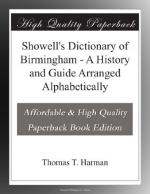Rebellion of 1745.—The first news of the Rebellion and of the landing of the Young Pretender reached here Aug. 19, 1745. The Scotch did not come so far as Birmingham, but [though thousands of swords were made here for “Bonnie Prince Charlie”] some little preparation was made to receive them. At a meeting held October 5, 1745, it was proposed to form a regiment of volunteers against them, and Sir Lister Holte found 250 horses to pursue the unfortunate “Pretender,” whose great-grandfather had been the guest of Sir Lister’s ancestor.
Rebus.—Poking fun at our town is no new game, as may be seen by the following local rebus (by “Dardanus”) copied from the Gentlemen’s Magazine of 1752:—
“Take three-fourths of a creature
which many admire,
That’s often confined in a castle
of wire;
Three-fourths of a herb that the garden
doth yield,
And a term used by husbandmen ploughing
the field;
With that part of a swine which is now
much in fashion,
And a town you’ll discover in this
brave English nation.”
The answer was Bird, Mint, G, and Ham—Birmingham, the scribe who poetically replied, [**]inding-up by saying that it was
“A town that in trading excels half
the nation,
Because, Jove be thanked, there is no
Corporation!”
Recorders.—The first Recorder appointed for the borough was Mr. Matthew Davenport Hill, whose name is so intimately connected with the history of Reformatory and Industrial Schools. Mr. Arthur Robarts Adams, Q.C., who succeeded Mr. M.D. Hill on his resignation in January, 1866, was a native of the county, and had acted as Deputy-Recorder for some years. He died in an apoplectic fit, while out shooting (Dec. 19, 1877), in Bagley Wood, near Oxford, in his 65th year. The present Recorder is Mr. John Stratford Dugdale, of Blythe Hall, Coleshill.
Recreation Grounds.—Early in 1854 Joseph Sturge set apart a field in Wheeley’s Lane as a public playground for children, and this must rank as the first recreation ground. The last is the disused burial ground of St. Mary’s Church, which, after an expenditure of about L1,500 was thrown open to the public as “St. Mary’s Garden,” October 16, 1882.—see “Parks.”
Red Book.—Quite a local institution is the yearly publication known as “The Birmingham Red Book,” which was first issued in 1865.
Reformatories.—See “Industrial Schools.”




